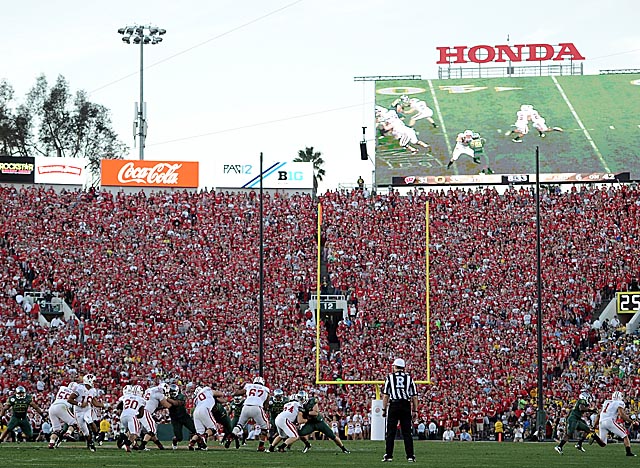
Slipping bowl attendance has BCS scrambling for reasons, fixes
First of two-part story
Since the Bowl Championship Series added a fifth BCS bowl game -- the BCS national title game -- after the 2006 regular season, attendance at the BCS bowl games has been on a steady decline.
In 2005, the last season before the addition of that title game, the Fiesta, Orange, Rose and Sugar bowls had a total announced attendance of 319,936, averaging 79,984 per bowl. This past season the announced attendance for those four bowls had dropped to 293,247; an average of 73,311 per bowl.
While there was a slight increase in 2010, this year's attendance numbers were 8 percent lower than the 2005 figures.
| BCS Bowl Attendance | |
| Year | Attendance |
| 2005 | 319,936 |
| 2006 | 319,822 |
| 2007 | 312,433 |
| 2008 | 310,814 |
| 2009 | 298,528 |
| 2010 | 300,682 |
| 2011 | 293,247 |
| Note: Figures do not include BCS championship games. Numbers are since 2005, the first year the BCS added a fifth game. | |
There is not one simple reason for the decline, which can be attributed to a variety of factors. Bowl officials mention the state of the economy as one reason, while others point to the exorbitant cost of tickets along with bad matchups requiring fans to fly cross-country for a midweek game played after New Year's Day.
Of the four BCS bowls, the Rose Bowl is the only event for which attendance numbers remain steady, in large part because it has featured its traditional Big Ten-Pac 12 matchup in five of the past six years.
The other three BCS bowls, however, have seen drastic decreases in attendance. The Orange Bowl's attendance numbers have slipped five of the past six seasons, while the Sugar Bowl's has decreased in four of the past six years.
"I will say that bowl attendance is still strong," BCS executive director Bill Hancock said. "Bowl games are immensely popular."
Hancock added that the 2005 regular season -- the final one before the fifth BCS bowl was added -- featured "some of the greatest matchups in bowl-game history" and that was another factor for the BCS bowls' decline in attendance since that season.
Overall, attendance at the 35 bowl games this past season was down about 2.5 percent from last season. Still, the most notable decline in attendance has been at the BCS bowls, specifically the Orange Bowl.
For the 10 years prior to the 2009 season, the Orange Bowl never drew less than 70,000 for each game. Yet in the past three years, the Orange Bowl has had an average announced attendance of 66,382 with the actual attendance much lower.
In the six years since the BCS title game was added, the Orange Bowl has had a 9.7 percent decrease in attendance compared with the 2005 season, the largest dropoff of the BCS bowls. The biggest reason may have been that in each of those six seasons, the Orange Bowl had the ACC champion paired against the Big East champion three times and an at-large team from the Big 12, Big Ten and Pac-12 one time each.
In that time frame, the Sugar Bowl had a 4.27 percent decrease in attendance and the 2012 Sugar Bowl between Michigan and Virginia Tech drew the bowl's second-lowest crowd since 1943. Since 2005, the Fiesta Bowl also has had a 3.65 percent decrease in attendance.
Compounding matters for the BCS bowls is that not only are fewer fans attending their bowls, but TV ratings also are on the decline.
The 2011-12 bowl season averaged 5.2 million viewers for 34 telecasts on ABC, CBS, ESPN, ESPN2 and Fox, down 15 percent from the 6.1 million viewers last year, Sports Business Journal reported.
"The ratings clock starts clicking down the more you get away from the Rose Bowl," a bowl source said. "You lose the buzz of a bowl game the further you get away from New Year's Day unless you have some spectacular matchup."
And, unlike Teri Hatcher's character on Seinfeld, this year's bowl lineup certainly was not spectacular.
The BCS bowls aren't the only bowls seeing a drop in attendance.
The Outback Bowl gets to choose from the nation's most rabid fan bases -- the SEC and Big Ten. Yet attendance at the Outback Bowl has declined in five of the past six seasons, dropping from 65,881 for the 2006 game steadily to 49,429 this past season. It always wasn't this way for the Tampa, Fla., bowl. Between 2000 and 2005, the Outback Bowl topped 65,000 in five of six seasons. This year's game failed to top 50,000 for the second time in three seasons and the actual attendance was only 40,002, meaning nearly 20 percent fewer fans were in the stadium than the number that was announced.
While the majority of bowls are experiencing dwindling attendance or rollercoaster-type numbers -- up one year, down the next -- the Champs and Insight bowls actually have flourished.
The Champs Bowl has seen attendance increases in nine of the past 10 seasons, while the Insight has had attendance increases in six of the past seven seasons. But those bowls are clearly the exceptions.
As far as what changes will be made to help bolster attendance for the BCS bowls when the new BCS cycle starts in 2014, Hancock said anything -- and everything -- is under consideration.
"Every idea is on the table for the future of the BCS, including moving away from midweek games after Jan. 1," Hancock said. "But it's too early to speculate about what changes, if any, might be made.
"Certainly there is no leader in the clubhouse. The [conference] commissioners will not make the decision in a vacuum."

No comments:
Post a Comment